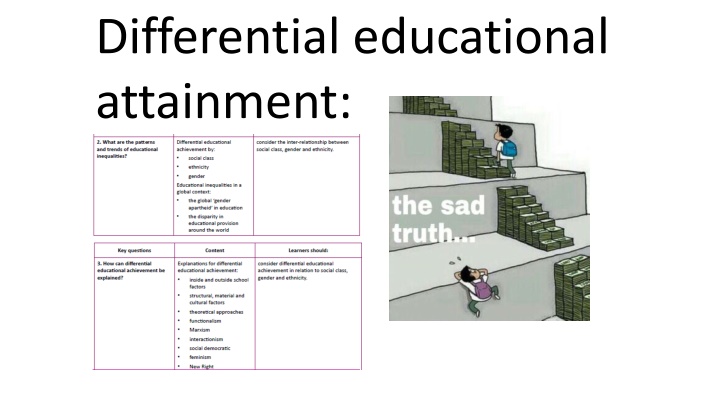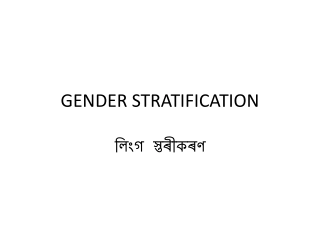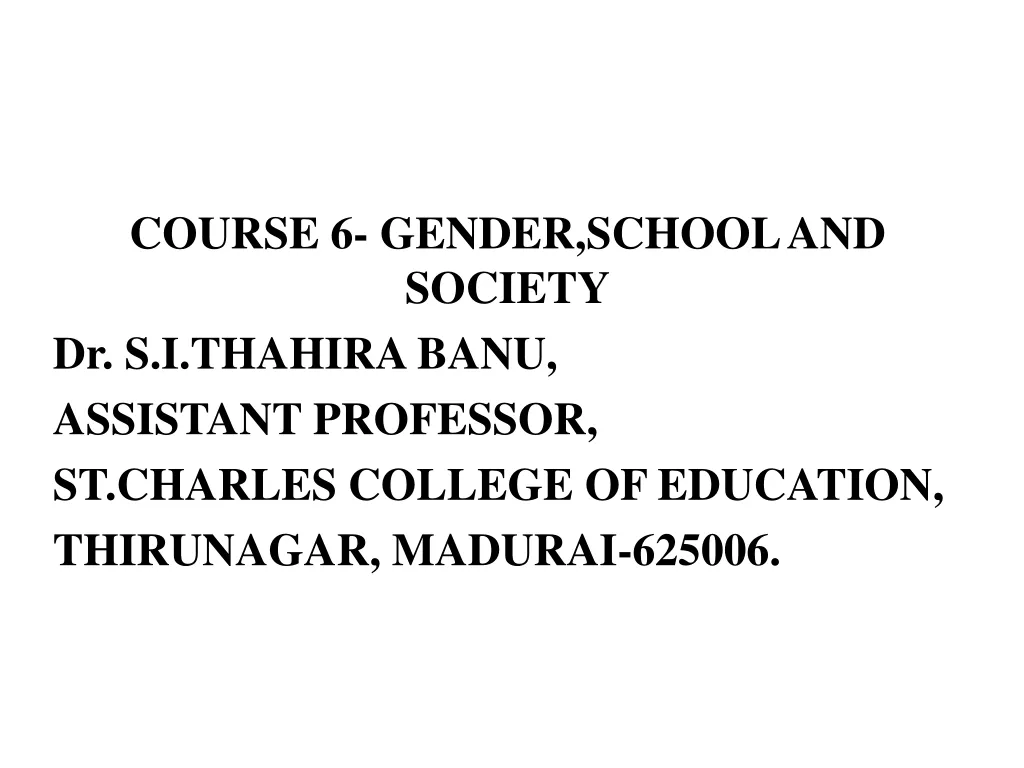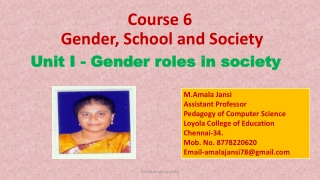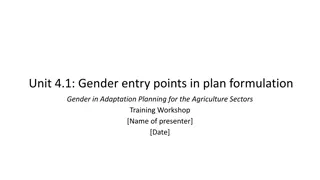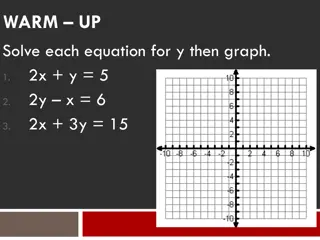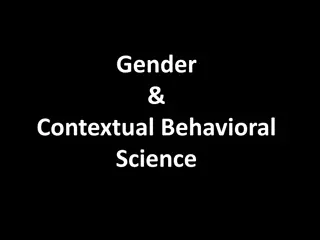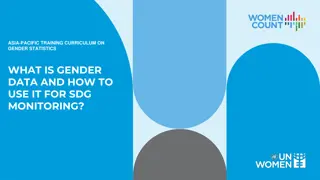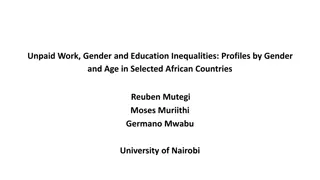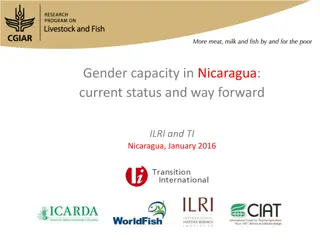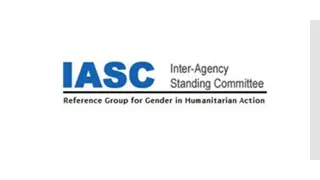Global Gender Inequalities in Education
Global gender apartheid, UN's aims and findings, feminist criticisms, gender apartheid measurement, UNESCO's reasons for gender inequalities, evaluative points, and more on educational inequalities globally.
Download Presentation

Please find below an Image/Link to download the presentation.
The content on the website is provided AS IS for your information and personal use only. It may not be sold, licensed, or shared on other websites without obtaining consent from the author.If you encounter any issues during the download, it is possible that the publisher has removed the file from their server.
You are allowed to download the files provided on this website for personal or commercial use, subject to the condition that they are used lawfully. All files are the property of their respective owners.
The content on the website is provided AS IS for your information and personal use only. It may not be sold, licensed, or shared on other websites without obtaining consent from the author.
E N D
Presentation Transcript
Differential educational attainment: Image result for differential educational attainment cartoon
Educational inequalities in a global context: Global gender inequalities in education: Read the information on pages 147-151 1. Explain what is meant by global gender apartheid 2. Explain the aims and findings of the UN regarding this 3. Explain the feminist criticisms of the UN s approach
4. How is gender apartheid measured? 5. Summarise the reasons identified by UNESCO for gender inequalities. 6. Summarise the evaluative points
Educational inequalities in a global context: Inequalities in educational provision Read the information on pages 147-151 1. Summarise the evidence of inequalities globally relating to: - Poverty and education - Ethnic inequalities - Locality
Image result for material deprivation education money Differential educational attainment by class: Explanations
Class inequalities in education: Key themes Read the information on page 114 1. Explain what is meant by equality of opportunity and why this is considered important 2. Explain how quantitative data have been used to measure class and educational attainment 3. Explain the interpretivist criticisms of this.
Source Education Endowment Foundation (EEF) which is an independent charity dedicated to breaking the link between family income and educational achievement.
10 mark question: In what ways are lower socio-economic classes deprived in education? 3 paragraphs, each explaining a distinct way that education contributes to society Use the information the textbook and the activity on page 114-115 to answer this question. Each paragraph needs a study / specific evidence Evidence (as a whole) must be fully explained in relation to the point made using subject specific language. Essentially 3 x PEE
Halifax Building Society (2006) A private education for a child between the ages of three to 18, will cost 326,000. For top private schools such as Millfield, Winchester and Eton, fees are approaching 25,000 a year. To get into the catchment area for one of the top-performing comprehensives in England you can expect to pay tens of thousands of pounds extra for a house.
To what extent do material factors explain different attainment levels between social groups? Image result for material deprivation education money What are the issues? What is the debate about? Material deprivation theories suggest that the working class experience poverty and deprivation. Children who grow up in poverty have the lowest levels of educational attainment. The gap between the poor and the remainder of the population is growing as the children grow older. Fewer from the working class go on to further and higher education. Sociologists explain this by referring to material deprivation. This leads to the failure of their children to benefit from the education system Whilst the negative impact of deprivation on education is recognised, it is not a sharp research focus in contemporary Britain, where the effectiveness of schools is considered to be more important for children s success. The key theories associated with material deprivation theory are Marxists and Social Democrats.
Image result for material deprivation education money What is material deprivation? Material deprivation is when people do not have items considered to be necessities by a majority of the population. According to government statistics, The UK has one of the worst records in Europe for high levels of child poverty. In 2007, 2.9 million British children were poor In 2004, one in four British children were poor 10.2 per cent of children in the UK (1.3 million) are classified as being in severe poverty. The fewer items a family has, the greater the degree of deprivation There is a strong association between parents low level of educational attainment and severe child poverty. Why is this? Is this still a problem in the UK?
Image result for material deprivation education money The impact of deprivation Children, who live in poverty often live in small, and sometimes cold houses. Poverty can also lead to sickness which could in turn lead to absence from school. There may be little space to work. Some children have to work in the evening and at weekends to get money and therefore there is no time for homework and preparing for examinations. There is no money available to buy resources to support the child's education, such as books, a computer, additional tuition etc. Poor diet Difficult working conditions Low pay work Low qualifications Poor health Poverty Prejudice and discrimination Criminality Fewer useful contacts Fewer opportunities
Image result for material deprivation education money Halsey, Heath and Ridge (1980s) Wedge and Prosser (1974) Longitudinal study of children born in one week in 1958. They were studied at age 11. Poor children are disadvantaged in terms of low income poor housing family composition (single parent or many siblings) Such children are more often ill, lighter at birth, and do less well in school compared with advantaged children. Published the famous longitudinal study Origins and Destinations. Poverty was identified as a critical factor in school failure. (Halsey identified as a socialist but essentially comes under the Marxist heading)
Image result for material deprivation education money Smith and Noble (1995) There are a number of additional hidden costs that are part of maintaining a child's education, school uniform, school dinners, travelling to school, necessary equipment, educational trips with the school
Image result for material deprivation education money Labour Force Survey (1999) 80% of those from professional social classes go on to higher education. 14% of those from unskilled backgrounds go on to higher education. When higher education opportunities expand, it is the middle classes who are more likely to take advantage of the increased investment by government. Fewer than 1% of those in unskilled work have a degree or higher qualification. 66% of professional people have a university degree.
Image result for material deprivation education money Fernstein (2003) The educational achievement of a 26 year old could be accurately predicted by the wealth of the household when the child was 22 months. Hutchings (2003) If students from low-income families went to university, they often had to get evening jobs in order to pay for their course. Gaps were already opening up in attainment levels between children of different social background before they had all of their first teeth. This may then possibly have the effect of them obtaining a lower degree or even having to leave the course before completing it.
Image result for material deprivation education money Kingdon and Cassen (2007) Factors associated with poverty such as free school meals, low levels of family employment, single parent families and poor educational qualifications of parents all contributed to low achievement. Disadvantaged children also attend schools that rate low in the league tables.
Image result for material deprivation education money Government policies designed to support poor children in education Funding The government has persisted in tackling problems of underachievement by creating policies that are directed at changing schools and teachers. EMA In 2002, the British government announced that it was providing a grant of 30 per week from September 2004 onwards to help some 16-19 year old students to stay in education. This scheme had already been piloted in some parts of the country and evidence showed a 6% increase in those who had stayed on in education. (DfES 2002) Unfortunately, these grants were small, and therefore there was insufficient assistance available for all those who wished to continue their education. 2010 New Conservative government abolished EMA. Pupil premium: Introduced by Liberal Democrats in coalition government Extra money is provided for students who qualify for free school meals (FSM) This is intended to be used to provide equipment, trips etc in order to make up the gap between rich and poor. Difficult to determine success evidence suggests that the attainment gap between PP and non-PP students hasn t closed (by some measures increased). School funding under the New Right was directed towards high achieving schools because it was believed that if schools were in competition for funding, they would all improve.
Image result for material deprivation education money 2016 Conservative government proposes reintroduction of grammar schools to help poor children Arguments for: Arguments against:
How does a higher family income assist a pupil from a middle class background? Image result for material deprivation education money Wealthier family Few children Good health Comfortable home Good education Staying rich and comfortable Influential friends Pleasant work
Image result for material deprivation education money Summary of key points Poverty has a negative impact on school attainment Education is a route to a comfortable and healthy life Many children in the UK are poor and will not achieve their full potential in education Rich people have strategies to avoid their children becoming poor education is part of that process
Evaluation: Read the evaluation of material factors on page 118. Summarise the arguments.
Task: Read the items in the activity on pages 118-119. Answer the questions at the end of the activity.
Do the working classes have a culture that leads to educational failure? To what extent do cultural factors explain different attainment levels between social groups? What is the debate about? Cultural deficit theories suggest that the working class have a culture which leads to educational failure for its children. They tend to claim that: The working class put less emphasis on formal education as a means of personal achievement, and see less value in staying on at school beyond the school- leaving age. Members of the working class place less value on attaining a higher occupational status than the middle class. There are cultural differences between the classes which act as a barrier to success for some children.
Do the working classes have a culture that leads to educational failure? To what extent do cultural factors explain different attainment levels between social groups? What are the issues? Is there a culture or cycle of disadvantage affecting working class children? Cultural explanations are usually associated with - Functionalist theorists - New Right theorists Is the culture of working class people different or deficient in some way from the culture of the middle classes? (and criticised by Marxists...)
Oscar Lewis (1950s) Introduced the idea of the culture of poverty. Poor people develop distinct sub-cultural values to enable them to survive poverty, but which disadvantaged their children in school. As individuals, people feel helpless and disempowered. By the age of six or seven, children have absorbed the values of their culture and cannot take advantage of opportunities that may occur.
J W B Douglas (1964) Douglas says that middle class parents show a greater interest in the education of their children. There is an emphasis on high attainment in middle class homes. Middle class parents keep in touch with the educational progress of their children. Working class parents do not feel at ease in a middle class situation such as a school.
Hyman (1960s) Members of the working class believe that there is less opportunity for personal advancement for them. This belief is likely to be the basis for the low value put on education and a higher occupational status. It is a realistic assessment of the situation - the working class has less opportunity however, the belief itself further reduces the opportunity.
Connor et al (2001) Connor et al (2001) conducted focus group interviews with 230 students from 4 different FE colleges from a range of class backgrounds, some of whom had chosen to go to university and some who had not chosen to go to University. The main findings were that working class pupils are discouraged from going to university for three main reasons: Firstly, such candidates want immediate gratification . They want to earn money and be independent at an earlier age. This is because they are aware of their parents having struggled for money and wish to avoid debt themselves Secondly, they realise that their parents cannot afford to support them during Higher Education and did not like the possibility of them getting into debt Thirdly, they have less confidence in their ability to succeed in HE.
Basil Bernstein (1970s) A linguist not a sociologist There are two language patterns in daily use - limited codes and extended codes. Limited code is everyday spoken language. Short simple sentences are used and often details and explanations are omitted. Extended code explains things in greater detail and uses long, complex sentences. Both languages are familiar to the middle class but only the limited code is used by the working class. Teachers in school use the extended code and therefore working class children are at a disadvantage from the outset.
Leon Fenstein Identified link between low income was related to the restricted speech code. - Children of working-class parents tend to be more passive; less engaged in the world around them and have a more limited vocabulary. - Children from middle-class households had a wider vocabulary, better understanding of how to talk to other people and were more skilled at manipulating objects.
Read the information on Bernstein. 1. Summarise the criticisms of Bernstein s work 2. Read the activity on pages 122-123. Answer the questions at the end of the activity
THE NEW RIGHT This view is very critical of working class culture, viewing them as agents of their own destruction. UNDERCLASS THEORIES (1990S) Charles Murray believes that children brought up in single parent families lack a male role model. Discipline in families has decreased. Young men are not correctly socialised. A culture develops that has these characteristics: Neglect and abuse of children Broken relationships Victimization by crime Despair and fatalism
Dalrymple (2001) The British underclass have developed a culture of: Passive thinking Denial of agency and personal responsibility Dishonesty and self-deception Rationalizations for self-induced helplessness, such as "addiction" Perverse, primitive, valueless sexualization Absolute refusal to apply or accept judgment
HOWEVER, FROM THE MARXISTS Cultural deprivation is viewed in a different way; the working class are victims of the system C. Wright-Mills (1950s) Elite self-recruitment. Members of the highest sectors of society prevent educational failure and protect their interests and those of their children by sending their children to the best public schools. Pierre Bourdieu (1977) The middle and upper classes have cultural capital as well as financial capital. They have an advantage over the working class because their parents give them support in terms of books and reading, literature, art, classical music, visits to museums, theatres and art galleries. This culture is closer to the culture of the school, and therefore they are more likely to be successful. This allows them the chance to acquire the social skills and background to rise to the best and most powerful positions.
Bourdieu: Cultural Capital Theory (p. 124-125) 1. Why does Bourdieu reject cultural deprivation theory? 2. Explain what Bourdieu suggests is the main role of education (explain cultural reproduction) 3. What does Bourdieu mean by cultural capital? 4. How does the possession of cultural capital benefit the middle and upper classes in terms of education
Bourdieu: Cultural Capital Theory (p. 124-125) 5. Explain what Bourdieu means when he suggests that one role of education is the social function of elimination 6. Identify strengths of Bourdieu s work 7. Identify criticisms of Bourdieu s work
Comparison: New Right and New Left views of cultural deprivation New Right The poor are to blame New Left The structure of society is to blame. Poor people did not choose to live in poor surroundings Poor people have developed a culture that is negative and selfish If the poor fail, it is the responsibility of the culture we have created. If the poor fail, it is their own responsibility.
Evaluation of cultural deficit theory: There is little evidence to support the underclass thesis. Most social scientists tend to see the problems of the working class as being related to the structures of society. It makes the working class take the blame for their own failure in education. There is little that is practical that governments or schools can do to solve the problem of working class underattainment Summary of key points Those who are at the bottom of the class system do not have the values, attitudes and special skills that are essential for educational success. Children and their families are to blame for educational failure. Children who are culturally deprived are lacking in essential skills, attitudes and values. A number of researchers have alleged that there are patterns of class differences.
How do processes within school affect educational attainment? Writers within the interpretive or interactional tradition of sociology (social action theory) are interested in the processes within schools which lead some children to failure. What is interactionism (social action theory): Interactionism is also called interpretivism. The methodology used is generally ethnomethodological It originated with the work of George H Mead. It looks at the detailed interaction between people.
How do processes within school affect educational attainment? Writers within the interpretive or interactional tradition of sociology (social action theory) are interested in the processes within schools which lead some children to failure. Herbert Blumer (1969) "Human beings act toward things on the basis of the meanings they ascribe to those things." "The meaning of such things is derived from, or arises out of, the social interaction that one has with others and the society." "These meanings are handled in, and modified through, an interpretive process used by the person in dealing with the things he/she encounters."
How do processes within school affect educational attainment? Writers within the interpretive or interactional tradition of sociology (social action theory) are interested in the processes within schools which lead some children to failure. Master status: Attitudes: AWe have a tendency to behave in a certain way toward some people. A person's master status is the most obvious thing about that person. It can be both negative or positive It controls the way they are identified in public. Teachers have attitudes built up over years of experience The master status becomes a label we attach to people. How does this apply to schools?
Self-fulfilling Prophecies This occurs when our beliefs and expectations create reality Our beliefs and expectations influence our behaviour and others Pygmalion effect person A believes that person B has a particular characteristic person B may begin to behave in accordance with that characteristic
Rosenthal & Jacobson (1964) Went to a school and did IQ tests with kids and told teachers that the test was a spurters test Randomly selected several kids and told the teacher they were spurters Did another IQ test at end of year, spurters showed significant improvements in their IQ scores It is argued that this is because of their teachers expectations of them The study was unethical and cannot be repeated. The methodology was not reliable Teachers could not remember the names of the spurters The theory is not well supported by the statistics in the study
The influence of teachers expectations: Hargreaves et al (1975) Deviance in class rooms teachers classify students, according to Hargreaves Read Hargreaves study on p. 127 Summarise the stages of how The success of labelling is dependent on other factors such as: how often the label is used, does the pupil accept and respect the teacher's opinion, do other teachers support the label, and is the label used publicly or privately?
